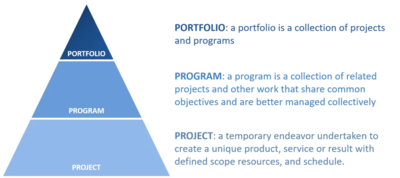Project Portfolio
Project Portfolio is a term that refers to an organization’s group of projects and the process in which they are selected and managed. The project portfolio is strategically selected to advance the corporation’s organizational goals. Generally speaking, organizations will have an opportunity for far more projects than funding can support, so the selection process must choose a subset of projects to maximize the company’s profit goals while obeying budgetary restrictions. Concurrently, executives wish to manage the overall risk of the portfolio while ensuring that cash flow and other such requirements are satisfied.[1]
For instance, a company in the energy sector might have as business objective to "reduce carbon emissions". This portfolio could include sub-portfolios such as "improving efficiency of solar energy production" or projects such as "streamlining transport routes". Defining portfolios allows project-rich organizations gain an overall perspective on their current and future projects and give priority access to resources to those projects that are most likely to help them achieve their strategic objectives.[2]
Project Vs. Portfolio Vs. Program[3]
Below is a brief overview of the difference between projects, programs, and portfolios.
- PORTFOLIO: a portfolio is a collection of projects and programs
- PROGRAM: a program is a collection of related projects and other work that share common objectives and are better managed collectively
- PROJECT: a temporary endeavor undertaken to create a unique product, service or result with defined scope resources, and schedule.
Project Portfolio Processes[4]
Project portfolio management requires a balance of time, skills, budgets, risk mitigation and running the projects in the portfolio frugally and expediently without sacrificing quality. Managers do this through the use of five key processes.
- Change Control Management: Identifying and prioritizing change requests. These can be feature requests, operational constraints, regulatory, etc., based on demand, financial and operational constraints.
- Risk Management: Identifying risks in projects that make up the portfolio, and developing contingencies and risk response plans in order to mitigate uncertainty within the project portfolio.
- Financial Management: Managing financial resources related to the projects in the portfolio and demonstrating financial value of the portfolio in relation to organizational strategy, goals and objectives.
- Pipeline Management: Ensuring project proposals are in the pipeline and determining if they’re worth executing.
- Resource Management: Efficiently and effectively using an organization’s resources, from materials and equipment to people and technical skills.
See Also
- IT Governance
- Project Life Cycle
- Project Management
- Project Portfolio Management (PPM)
- Project Portfolio Rationalization
References
- ↑ Defining Project Portfolio Upland Software
- ↑ Explaining Project Portfolio with Example Planisware
- ↑ Project Vs. Portfolio Vs. Program Acuity PPM
- ↑ 5 Project Portfolio Processes Project Manager

